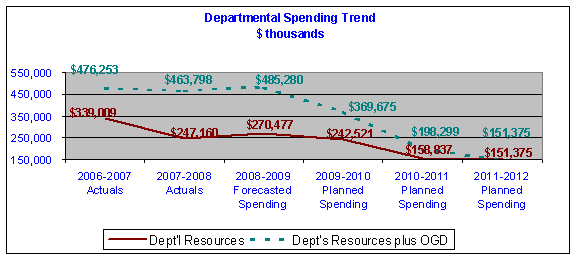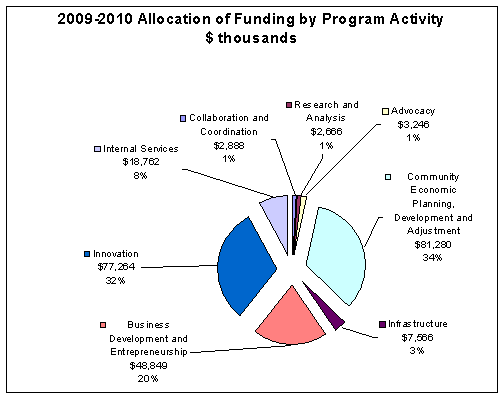Common menu bar links
Breadcrumb Trail
ARCHIVED - Western Economic Diversification Canada
 This page has been archived.
This page has been archived.
Archived Content
Information identified as archived on the Web is for reference, research or recordkeeping purposes. It has not been altered or updated after the date of archiving. Web pages that are archived on the Web are not subject to the Government of Canada Web Standards. As per the Communications Policy of the Government of Canada, you can request alternate formats on the "Contact Us" page.
Minister’s Message
Protecting Western Canada’s Future

As Minister responsible for Western Economic Diversification, I am pleased to present the department’s Report on Plans and Priorities for 2009–2010.
Since 1987, Western Economic Diversification Canada (WD) has worked on behalf of western Canadians to ensure the long-term development and diversification of a dynamic regional economy. Western Canada’s rich and diverse natural heritage, coupled with a growing innovation and entrepreneurial culture, contributes to the region’s economic stability and prosperity.
As Canada navigates today’s global economic uncertainty, WD will continue to work to help address the challenges faced by western communities and businesses. Now more than ever, WD’s role supporting economic diversification and investing in innovation and economic development will help to effectively bridge the gap between economic downturn and recovery.
In the coming year, WD will continue to strengthen Western Canada’s economy by investing in projects, programs and partnerships that support entrepreneurship, strengthen and contribute toward a sound economic future for western Canadians.
The Honourable Jim Prentice, P.C., Q.C., M.P.
Minister of State’s Message
New ideas, new business, new jobs

Western Canada’s abundance of natural resources, entrepreneurial talent, and innovative leaders make the West a truly dynamic economic driver for Canada. Western Economic Diversification Canada (WD) continues to build a sound western economy by growing new ideas, supporting new business, and creating new jobs.
Innovation drives economic growth – it is about the new ideas that bring economic benefits from research. WD will concentrate its investments in research and development while focusing on bringing new products, services, and technologies to market. WD investments in the research, technologies, and people that create value from ideas position the West as a leader in innovation. Through innovation, we strengthen the economy for the long-term.
WD has taken many steps to support our entrepreneurs and this support fuels new business. Entrepreneurs have access to 100 points of service across the West that provide business advice and services to help them succeed by improving skills, increasing access to capital, and expanding participation in key export markets.
WD also works closely with western communities to diversify their economies. By helping communities take advantage of economic opportunities and adjust to changing economic circumstances, we are maintaining and creating new jobs. Combined with our delivery of community infrastructure, on behalf of Infrastructure Canada through the Building Canada plan, we are strengthening the West for the long-term.
It is important that our programs and policies remain relevant and effective for the West. In order to achieve these goals, WD regularly consults with western Canadians to better understand regional needs and represents the West in national decision making.
As we move forward, we will continue to help build on regional strengths to diversify the western economy by investing in western communities, entrepreneurs and innovators. At WD, we know that a strong West will mean a stronger Canada.
The Honourable Lynne Yelich, P.C., M.P.
Section I – Department Overview
1.1 Summary Information
Raison d’être & Responsibilities
Western Economic Diversification Canada was established in 1987 to lessen the West’s (Manitoba, Saskatchewan, Alberta and British Columbia) strong economic dependence on its natural resources. Under the Western Economic Diversification Act, 1988, the department is mandated to:
WD’s Deputy Minister (DM) is based in its Headquarters office in Edmonton, Alberta. Regional offices are located in each of the western provinces – Vancouver, Edmonton, Saskatoon, and Winnipeg, with a liaison office in Ottawa and regional satellite offices in Calgary and Victoria.
To be leaders in creating a more diversified western Canadian economy that has strong, competitive and innovative businesses and communities
WD’s programs to encourage entrepreneurship, innovation and community economic development are supported by the Department’s leadership and coordination role in furthering western interests and responding to western challenges. The Department works strategically through partnerships – with all orders of government, academic and research institutes, industry associations, and not-for-profit organizations – to implement initiatives that leverage funds and expertise for the benefit of the West and westerners.
Through its core resources, WD:
- Implements multi-year contribution programming such as the Western Economic Partnership Agreements (WEPAs) with western stakeholders. These agreements between the Government of Canada and the four western provinces address economic challenges by investing in shared priorities that include –
- supporting the creation and growth of research and development, with a focus on getting new products, technologies and services out to market;
- supporting trade and investment;
- enhancing business productivity and competitiveness; and
- increasing value-added production in traditional industries.
- Invests in pan-western and other projects that are focused on delivering results that contribute to WD’s Strategic Outcomes; and
- Supports the Western Canada Business Service Network which provides more than 100 points of service in rural and urban communities across the West where entrepreneurs can get assistance in starting and growing businesses.
In support of national initiatives on behalf of the federal government, WD also:
- Delivers initiatives to mitigate the impact of the Mountain Pine Beetle infestation in the province of BC; and
- Works with provinces and municipalities to deliver a variety of infrastructure programming in the West, in partnership with Transport, Infrastructure and Communities Portfolio departments.
Strategic Outcomes
In order to effectively pursue its mandate, WD aims to achieve the following strategic outcomes:
- The western Canadian economy is competitive, expanded and diversified -Entrepreneurship and Innovation
- Communities in Western Canada are economically viable -Community Economic Development
- Policies and programs that strengthen the western Canadian economy – (Policy, Advocacy and Coordination)
During this reporting period, WD will focus on the following operational priorities in order to achieve progress towards its Strategic Outcomes and better results for Canadians:
- Technology Commercialization,
- Trade and Investment,
- Business Productivity and Competitiveness, and
- Rural Diversification.
In addition, the Department has chosen to focus attention on the following management priorities which commit WD to strive towards a level of excellence in the management of its allocated resources in pursuing its Strategic Outcomes:
- Public Service Renewal,
- Performance Measurement, and
- Integrated Risk Management.
Through these investments, along with WD’s leadership in advocating for and responding to western challenges, WD is building a stronger West in a stronger Canada.
Program Activity Architecture
The chart below illustrates WD’s complete framework of program activities and program sub-activities, which roll-up and contribute to progress toward WD’s Strategic Outcomes.

1.2 Planning Summary
| 2009-2010 | 2010-2011 | 2011-2012 |
|---|---|---|
| 242,521 | 158,837 | 151,375 |
The financial resources table above provides a summary of the total planned spending for WD for the next three fiscal years.
Explanations for reductions in planned spending for this period are covered under each of the Strategic Outcomes.
| 2009-2010 | 2010-2011 | 2011-2012 |
|---|---|---|
| 401 | 386 | 383 |
The human resources table above provides a summary of the total planned human resources for WD for the next three fiscal years. The decrease in FTE count in future years reflects the sunsetting of the incremental funding provided in Budget 2005, and the Municipal Rural Infrastructure Funding program.
| Vote # or Statutory Item (S) | Truncated Vote or Statutory Wording | 2008-09 Main Estimates |
2009-10 Main Estimates |
|---|---|---|---|
| 1 | Operating expenditures | 48,753 | 41,725 |
| 5 | Grants and contributions | 215,271 | 195,245 |
| (S) | Contributions to employee benefit plans | 5,322 | 4,801 |
| Total | 269,346 | 241,771 | |
| Performance Indicators | Targets |
|---|---|
| Real Gross Domestic Product (GDP) growth | 3.2% (Stable growth rate) |
|
Annual International Trade: value of exports excluding primary production sectors, $ million |
$42,922 (Increase) |
|
Research & Development (R&D) intensity: Gross Domestic Expenditures on R&D (GERD) as % of GDP |
1.3% (Stable) |
| Program Activity | Expected Results | Forecast Spending 2008-09 ($ thousands) |
Planned Spending ($ thousands) |
Alignment to Government of Canada Outcomes | ||
|---|---|---|---|---|---|---|
| 2009-2010 | 2010-2011 | 2011-2012 | ||||
|
Business Development and Entrepreneurship |
Strong SMEs in Western Canada with improved capacity to remain competitive in the global marketplace. | 58,043 | 48,849 | 38,989 | 38,478 | Strong Economic Growth |
|
Innovation |
A stronger knowledge-based economy. | 87,506 | 77,264 | 55,036 | 49,070 | An Innovative and Knowledge-based Economy |
| Total for SO 1 | 145,549 | 126,113 | 94,025 | 87,548 | ||
Business Development and Entrepreneurship – The change in planned spending for Business Development and Entrepreneurship in 2009–2010 and future years is due to a reallocation of resources to the new Internal Services program activity and the sunsetting of the incremental funding provided in Budget 2005 and the Canada Business service centres1, pending renewal of this program.
Innovation – The change in planned spending for Innovation in 2009–2010 and future years is primarily due to the completion of the construction of the International Vaccine Centre’s (InterVac) Biosafety Level II Containment Facility in Saskatoon, the reallocation of resources to the new Internal Services program activity and the sunsetting of the incremental funding provided in Budget 2005.
| Performance Indicators | Targets |
|---|---|
|
Disposable income per capita |
$31,082 (Increase) |
|
Labour productivity growth – real GDP per hour worked |
1.2% (Stable growth rate) |
| Program Activity | Expected Results | Forecast Spending 2008-09 ($ thousands) |
Planned Spending ($ thousands) |
Alignment to Government of Canada Outcomes | ||
|---|---|---|---|---|---|---|
| 2009-2010 | 2010-2011 | 2011-2012 | ||||
|
Community Economic Planning, Development and Adjustment |
Communities have increased economic opportunities and capacity to respond to challenges. | 109,506 | 81,280 | 37,389 | 36,946 | Strong Economic Growth |
|
Infrastructure |
To maximize economic, social, cultural and environmental benefits to western Canadians through investments in public infrastructure in a coordinated manner with provincial and municipal governments. | 2,265 | 7,566 | 1,040 | 574 | Strong Economic Growth |
| Total for SO2 | 111,771 | 88,846 | 38,429 | 37,520 | ||
Community Economic Planning, Development and Adjustment – The change in planned spending for Community Economic Planning, Development and Adjustment in 2009–2010 and future years is primarily due to the completion of the Mountain Pine Beetle Initiatives (Community Economic Diversification Initiative and the Airport Improvements Initiative) as well as the Alberta and Saskatchewan Centenaries projects. It also reflects a reallocation of resources to the new Internal Services program activity and the sunsetting of the incremental funding provided in Budget 2005.
Infrastructure – The change in planned spending for Infrastructure in 2009–2010 and future years is due to the sunsetting of the Infrastructure Canada Program funding and the reduced operating resources related to the delivery of the Municipal Rural Infrastructure Fund.
WD continues to deliver programs such as the Municipal Rural Infrastructure Fund (MRIF) and projects under the Canada Strategic Infrastructure Fund (CSIF), on behalf of Infrastructure Canada, through an Other Government Department (OGD) suspense account. Under this delivery mechanism the Grants and Contributions resources associated with these programs are reflected in Infrastructure Canada’s reference level. WD will deliver the Building Canada Fund – Community Component and non-transportation related Major Infrastructure Component projects over a seven-year period.
| Performance Indicators | Targets |
|---|---|
|
Percentage of key informants with the opinion that WD activities provide policies and programs that support the economic development of Western Canada. |
55% |
|
$’s of project funding ($’s WD project funding plus $’s leveraged) |
$350,040,000 |
|
% of projects completed this fiscal year that successfully met or exceeded performance targets |
85% |
| Program Activity | Expected Results | Forecast Spending 2008-09 ($ thousands) |
Planned Spending ($ thousands) |
Alignment to Government of Canada Outcomes | ||
|---|---|---|---|---|---|---|
| 2009-2010 | 2010-2011 | 2011-2012 | ||||
| Collaboration and Coordination | Better-coordinated economic development activities, policies and programs in the West. | 6,055 | 2,888 | 2,789 | 2,783 | Strong Economic Growth |
| Research and Analysis | Improved understanding of western Canadian economic issues, challenges, opportunities and priorities. | 4,254 | 2,666 | 2,610 | 2,606 | Strong Economic Growth |
| Advocacy | Decisions by other organizations that improve economic policies and programs in the West. | 2,818 | 3,246 | 3,211 | 3,213 | Strong Economic Growth |
| Total for SO3 | 13,127 | 8,800 | 8,610 | 8,602 | ||
Collaboration and Coordination; Research and Analysis; and Advocacy - The changes in these three program activities are primarily the result of the reallocation of WD operating resources to the new Internal Services Program Activity.
| Program Activity | Forecast Spending 2008-09 ($ thousands) |
Planned Spending ($ thousands) |
Alignment to Government of Canada Outcomes | ||
|---|---|---|---|---|---|
| 2009-2010 | 2010-2011 | 2011-2012 | |||
| Internal Services | N/A | 18,762 | 17,773 | 17,705 | Strong Economic Growth & An Innovative and Knowledge-based Economy |
| Total for SO 4 | N/A | 18,762 | 17,773 | 17,705 | |
Contribution of Priorities to Strategic Outcome(s)
| Operational Priorities | Type2 | Links to Strategic Outcome (SO) & Program Activity (PA) | Description |
|---|---|---|---|
|
Technology Commercialization |
Ongoing |
SO 1 |
Why is this a priority?
Plans for meeting the priority
|
|
Trade and Investment |
Ongoing |
SO 1 |
Why is this a priority?
Plans for meeting the priority
|
|
Business Productivity and Competitiveness |
Previously committed to |
SO 1 |
Why is this a priority?
Plans for meeting the priority
|
|
Rural Diversification |
Previously committed to |
SO 1 |
Why is this a priority?
Plans for meeting the priority
|
WD places a priority on Management Excellence and continues to make progress in improving management practices as encouraged through the annual Management Accountability Framework assessment.
| Management Priorities – Management Excellence | Type | Links to Strategic Outcome(s) | Description |
|---|---|---|---|
|
Public Service Renewal |
Previously committed to |
SO 1 |
Why is this a priority?
Plans for meeting the priority
|
|
Previously committed to |
SO 1 |
Why is this a priority?
Plans for meeting the priority
|
|
|
Integrated Risk Management |
Previously committed to |
SO 1 |
Why is this a priority?
Plans for meeting the priority
|
Risk Analysis
It is anticipated that during 2009–2010 WD will face some significant challenges in achieving its strategic outcomes and priorities stemming from largely negative and unstable economic conditions forecasted for Western Canada and throughout the global economy. WD’s mandate is to support economic development and diversification in the West. Implementing this mandate takes on a greater prominence and complexity during a period of major economic downturn when the region is facing low commodity prices and low or even negative economic growth in many sectors and areas of its economy.
As a commodity driven and trade oriented economy, much of Western Canada’s economic performance depends heavily on the resource sector and is vulnerable to world market conditions and the volatility of commodity prices. Economic growth in Western Canada has slowed significantly in 2008 and the outlook for 2009–2010 is deteriorating. Private sector forecasts, which
are the basis for developing WD’s target for real GDP growth for the region to guide its own strategies and priorities, have been downgraded considerably over the last few months.
While cognizant of these challenges WD, as the federal government’s regional development agency in Western Canada, is well positioned to advance the federal government’s agenda in stimulating the economy in the region while supporting projects and programs that position western Canadian industries, individual firms, and R&D organizations to compete effectively in the
global economy over the long term. The priorities and plans outlined in our Report on Plans and Priorities are designed to respond to current economic conditions in the West, while ensuring the Department remains flexible and responsive enough to address new challenges and opportunities that might emerge in the highly uncertain global marketplace.
In terms of general economic risk, as was recently highlighted in the June 2008 report of the Competition Policy Review Panel “Compete to Win”, a significant challenge to the West’s long term economic health and global competitiveness is the low rate of productivity in comparison to many of our most important global competitors - particularly the US which is by far our largest trade partner. Some key factors hindering productivity growth in Western Canada’s business sector include low investment in new machinery and equipment, slow adoption of new process and technology, lack of “capacity” to improve efficiency, lagging workplace training, and lack of human and financial capital. Productivity is also impacted by the shortage of skilled labour in Western Canada, as less skilled workers tend to be less productive. The trend of skilled labour shortage will likely persist as the West’s demographic structure shifts and more baby boomers move toward retirement.
To improve its competitive position in a global environment, Western Canada is challenged to create a more innovative, productive and diversified economy with a strengthened science and technology capability. Public investment in the economy of the West must place a priority on ensuring that research institutions and industries in the region support innovation, value-added production and the commercialization of new products, technologies and services into Canadian and international markets. This must be accomplished in a way that leverages new private sector investment that will build on the existing strengths of the industrial structure of each province, and also supports the development of new, knowledge-based industries and economic output driven by research and the commercial application of new discoveries and innovations. To stimulate new value added economic activity, business formation and skilled job creation, it is important to ensure that the environment and infrastructure for doing business in the West provides a strong foundation for improved productivity and competitiveness. Equally important are policies and programs that facilitate access to early stage capital, which is often an impediment to growth, especially for start-ups and small- and medium-sized enterprises (SMEs).
As much of the economy relies on trade, particularly with the US, Western Canada is sensitive to US’ economic recession, world economic slowdown and the fluctuation of the currency. In addition, many parts of Western Canada continue to be challenged with environmental and sustainability issues from resource extraction.
To counter the economic and business risks faced by many firms and industries due to uncertain continental and global market conditions, a greater emphasis must be placed on supporting western Canadian firms to access federal procurement opportunities at home and abroad, while capitalizing on our strategic positioning in the Asia-Pacific region and along the North, Central and South American corridors. The growing capacity of western Canadian research institutions and industries in key emerging sectors like aerospace, life sciences and biotechnology, environmental and new energy technologies, and nanotechnology has created opportunities to develop and secure new markets that represent long term growth for the West.
WD’s plans and priorities for 2009–2010 reflect a strong alignment with the needs of the western Canadian economy over the next year, and support key Government of Canada economic priorities and strategies. As the global economy adjusts to recent economic and financial shocks, the Department will maintain a flexible policy framework to ensure it remains relevant to its clients and maintains strong partnerships. This framework will allow WD to provide coordination and make strategic financial investments in support of the Department’s mandate and to ensure the continued development and diversification of the western economy to support overall Government of Canada priorities and plans.
When implementing its plans for 2009–2010 WD must also address some internal risks related to recruiting and retaining a skilled labour force in what is expected to be a continued highly competitive labour market, maintaining operational continuity, and demonstrating results for Canadians during a period of economic volatility and uncertainty. To respond to these challenges, WD will continue to place a priority on management excellence. This includes a focus on meeting Public Service Renewal objectives, including more fully integrating human resources planning with business planning to ensure we have the right people with the right skills in the right jobs, increasing our organizational capacity to measure and report on our impacts and results for Canadians, and refining our approach to risk management to ensure a sound understanding of operational and management risks faced by the Department and the implementation of policies and practices to ensure public funds are well managed and accounted for.
Expenditure Profile
For the 2009–2010 fiscal year, WD plans to spend $242.5 million to meet the expected results of its program activities and contribute to its strategic outcomes.
The figure below illustrates WD’s spending trend from 2006-07 to 2011–2012.

Although the Department's resources as reflected in the chart have been reduced significantly due to the sunsetting of the Infrastructure Canada Program, WD continues to deliver programs such as the Municipal Rural Infrastructure Fund (MRIF) and projects under the Canada Strategic Infrastructure Fund (CSIF), on behalf of Infrastructure Canada, through an Other Government Department (OGD) suspense account. Under this delivery mechanism, the Grants & Contribution resources associated with these programs are reflected in Infrastructure Canada's reference levels. WD is the delivery agent for the Community Component of the Building Canada Fund, totalling contributions of $334.5 million over a seven-year period, although only the operating funding to deliver the program will be reflected in WD’s reference levels.

